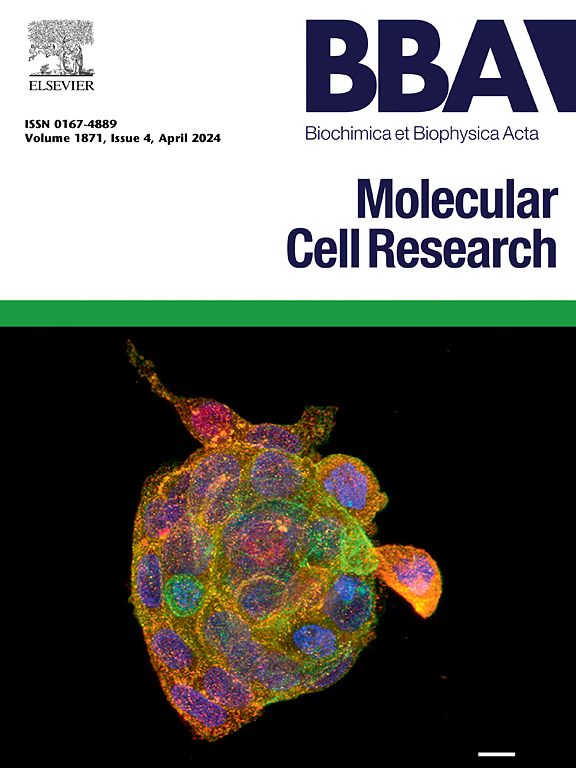Transcription factor EP300 targets SIRT5 to promote autophagy of nucleus pulposus cells and attenuate intervertebral disc degeneration
IF 3.7
2区 生物学
Q1 BIOCHEMISTRY & MOLECULAR BIOLOGY
Biochimica et biophysica acta. Molecular cell research
Pub Date : 2025-03-15
DOI:10.1016/j.bbamcr.2025.119933
引用次数: 0
Abstract
Background
Intervertebral disc degeneration (IVDD) is a prevalent spinal ailment and the leading cause of chronic low back pain. Understanding the exact pathogenesis of IVDD and developing targeted molecular drugs will be important in the future. Autophagy plays a key role in the metabolic processes and in the quality control of proteins in IVDD. However, the role of autophagy in the senescence of nucleus pulposus cell (NPC), the primary cells in the intervertebral disc responsible for maintaining the disc's structure and function, is not yet clear.
Methods
Gene expression profiling data of human disc tissue were obtained from the Gene Expression Omnibus GSE15227, GSE23130, and GSE70362 datasets. Autophagy-related differentially expressed genes were identified from the Molecular Signatures Database (MSigDB) database. Weighted gene co-expression network analysis (WGCNA), receiver operating characteristic (ROC) curves, and least absolute shrinkage and selection operator (LASSO) regression identified an autophagy-related hub gene that encodes the E1A binding protein EP300 transcription factor in IVDD samples. Potential downstream target genes of EP300 were identified by bioinformatics analysis. The analysis identified sirtuin 5 (SIRT5) as a potential downstream target of EP300. Chromatin immunoprecipitation (ChIP)-qPCR, small interfering RNA (siRNA), and luciferase reporter gene assays were used to verify the interaction of EP300 and SIRT5 in vitro. For in vivo experiments, SIRT5 knockout mice and SIRT5-overexpressing adeno-associated virus serotype 5 (AAV5) were constructed to verify the effect of the EP300–SIRT5 signal axis on the progression of IVDD.
Results
EP300 expression was reduced in the IVDD samples compared with its expression in healthy disc tissue samples. The reduced EP300 expression inhibited the occurrence of autophagy, which promoted NPC senescence. ChIP-qPCR and luciferase reporter gene assays showed that EP300 promoted SIRT5 expression by direct binding to its promoter. Activation of EP300 expression increased SIRT5 expression and significantly improved autophagy for inhibition of NPC senescence. In vivo experiments confirmed that knockdown of EP300 promoted NPC senescence and led to an exacerbation of IVDD, which was reversed by SIRT5 overexpression.
Conclusion
Our results provide the first evidence for the importance of EP300 and SIRT5 interactions in promoting IVDD development by inhibiting autophagy during IVDD. The EP300–SIRT5 signaling axis was identified as a promising target for therapy of IVDD based on autophagy genes.
转录因子EP300靶向SIRT5,促进髓核细胞自噬,减轻椎间盘退变。
背景:椎间盘退变(IVDD)是一种常见的脊柱疾病,也是慢性腰痛的主要原因。了解IVDD的确切发病机制和开发靶向分子药物在未来将具有重要意义。自噬在IVDD的代谢过程和蛋白质质量控制中起着关键作用。然而,自噬在髓核细胞(NPC)衰老中的作用尚不清楚,髓核细胞是椎间盘中负责维持椎间盘结构和功能的原代细胞。方法:从Gene expression Omnibus GSE15227、GSE23130和GSE70362数据集中获取人椎间盘组织基因表达谱数据。从分子特征数据库(MSigDB)数据库中鉴定出自噬相关的差异表达基因。加权基因共表达网络分析(WGCNA)、受试者工作特征(ROC)曲线和最小绝对收缩和选择算子(LASSO)回归在IVDD样本中发现了一个编码E1A结合蛋白EP300转录因子的自噬相关枢纽基因。通过生物信息学分析确定EP300的潜在下游靶基因。分析发现sirtuin 5 (SIRT5)是EP300的潜在下游靶点。采用染色质免疫沉淀(ChIP)-qPCR、小干扰RNA (siRNA)和荧光素酶报告基因检测验证EP300与SIRT5在体外的相互作用。在体内实验中,构建SIRT5敲除小鼠和SIRT5过表达腺相关病毒血清型5 (AAV5),验证EP300-SIRT5信号轴对IVDD进展的影响。结果:EP300在IVDD组织中的表达低于正常椎间盘组织。EP300表达的降低抑制了自噬的发生,促进了鼻咽癌的衰老。ChIP-qPCR和荧光素酶报告基因检测显示,EP300通过直接结合SIRT5启动子促进SIRT5的表达。激活EP300表达增加SIRT5表达,显著改善自噬,抑制鼻咽癌衰老。体内实验证实,EP300的下调可促进鼻咽癌衰老,导致IVDD加重,而SIRT5的过表达可逆转这一过程。结论:我们的研究结果首次证明了EP300和SIRT5相互作用通过抑制IVDD期间的自噬来促进IVDD发展的重要性。EP300-SIRT5信号轴被认为是基于自噬基因治疗IVDD的一个有希望的靶点。
本文章由计算机程序翻译,如有差异,请以英文原文为准。
求助全文
约1分钟内获得全文
求助全文
来源期刊
CiteScore
10.00
自引率
2.00%
发文量
151
审稿时长
44 days
期刊介绍:
BBA Molecular Cell Research focuses on understanding the mechanisms of cellular processes at the molecular level. These include aspects of cellular signaling, signal transduction, cell cycle, apoptosis, intracellular trafficking, secretory and endocytic pathways, biogenesis of cell organelles, cytoskeletal structures, cellular interactions, cell/tissue differentiation and cellular enzymology. Also included are studies at the interface between Cell Biology and Biophysics which apply for example novel imaging methods for characterizing cellular processes.

 求助内容:
求助内容: 应助结果提醒方式:
应助结果提醒方式:


